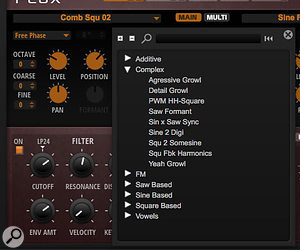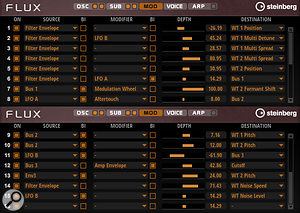 Flux is a wavetable-based synth engine, included in Cubase Pro and Artist 9.5’s Halion Sonic SE3.
Flux is a wavetable-based synth engine, included in Cubase Pro and Artist 9.5’s Halion Sonic SE3.
Looking for a new synth? Check out Cubase’s latest bundled one first!
Cubase 9.5 brought Pro and Artist users the Flux wavetable synth engine in Halion Sonic SE 3, and it offers something very different from Cubase’s other synths. It features twin wavetable oscillators, sub and noise sound sources, flexible filter, envelope and LFO options, a very well-featured arpeggiator, and a powerful, yet accessible, modulation matrix. Wavetable synthesis can be quite versatile for sound creation, and a great starting point for ‘other worldy’ pads in particular. In fact, Flux ships with some very cool presets that fall into this category, so to explain how you can make the most of it, I’ll deconstruct one of those presets, called Butterfly Dreams.
Give A Wave
Flux’s control set is spread over five tabbed sections (Osc, Sub, Mod, Voice and Arp) in the upper half of the GUI. The lower half shows options for the filter, the filter envelope, amplitude envelope, a further envelope (E3), and twin LFOs. Components in the Osc, Sub and Arp sections can also be turned on/off via the small LED-style buttons (orange when on). The filter, envelope and LFOs are of decent quality but (initially, at least) they follow pretty standard modes of operation. So we’ll start with a unique element of the engine — the wavetable-based oscillators.
 There are over 70 wavetables to explore for the two main oscillators.In order to hear what these oscillators are doing: (a) turn off the Sub sections (both sub octave and noise generators); (b) turn off the Arp; (c) visit the Mod screen and disable any pre-configured modulation (disable any On buttons; you might have to scroll down the full list of 16 modulation matrix lanes to see them all); (d) disable the Filter; and finally (e) turn off any of the HSSE3 effects that the preset happens to use — you can disable these via the main HSSE3 Effects screen and the Quick Controls located beneath the main Flux display. This should leave you with just the sound of the oscillators plus the amplitude envelope.
There are over 70 wavetables to explore for the two main oscillators.In order to hear what these oscillators are doing: (a) turn off the Sub sections (both sub octave and noise generators); (b) turn off the Arp; (c) visit the Mod screen and disable any pre-configured modulation (disable any On buttons; you might have to scroll down the full list of 16 modulation matrix lanes to see them all); (d) disable the Filter; and finally (e) turn off any of the HSSE3 effects that the preset happens to use — you can disable these via the main HSSE3 Effects screen and the Quick Controls located beneath the main Flux display. This should leave you with just the sound of the oscillators plus the amplitude envelope.
Butterfly Dreams uses the Comb Squ 02 and Sine Format Sweep wavetables. Auditioning these in isolation is instructive. Osc1 is somewhat nasal-sounding, while Osc2 is a bland organ-like noise — so there’s nothing to get too excited about yet! A drop-down menu allows you to change the wavetable used in each oscillator, so you can explore some alternatives. You can also change the pitch (octave, coarse, fine) and toggle on/off Multi and Formant modes for each oscillator.
The Osc section has two tabs: Main and Multi. Toggling between these brings up a different set of four knobs, all of which influence the oscillator’s behaviour. In the Main tab, the Level and Pan knobs are self-explanatory, but the Position knob determines the waveform’s playback starting point from within the selected wavetable. Generally, things get more harmonically interesting with higher Position values.
The Formant knob, only available if the Formant option is switched on, allows you to adjust how the resonant frequencies that define the character of the sound are handled as the oscillator is triggered at different pitches. I’ll leave aside the physics, and simply suggest that experimenting with this knob can produce some nice tonal variations with negative values producing darker tones and vice-versa.
 The Oscillator Multi tab offers lots of parameters for adding additional harmonic complexity.
The Oscillator Multi tab offers lots of parameters for adding additional harmonic complexity.
You can coax further harmonic complexity from these seemingly humble sounds by engaging the Multi options and exploring the associated controls. For example, take the Sine Format Sweep waveform (Osc2), set Spread to 0, a modest (<10) Detune value and then adjust the Number knob from zero through its full range, and you’ll begin to hear a richer (in harmonic terms) sound. The Multi option triggers multiple instances of the waveform, with the Number parameter specifying the number of multiples. If you want to go from ‘harmonically rich’ to ‘weird dissonance’, ramp up the Detune control — it’s great for taking you into more disturbing ‘sound-design’ territory!
Finally, dialing in some Spread adds further interest, as each waveform instance starts playback at a different point in the wavetable. Things get harmonically richer still with higher Spread values, as illustrated in the oscillator waveform displays.
With the Butterfly Dreams preset, the wavetables are at the more complex end of those available. Both oscillators are also used in Multi mode, with Osc1 having a high Position setting and Osc2 applying a little Spread. All these choices make for a good starting point if you are after a harmonically complex pad sound.
Less Is More?
It’s tempting to move swiftly on to the sub, filter, envelope, modulation and effects sections — to ‘fill out’ your sound — but it’s worth spending time with these elements disabled, exploring just how far you can take this neutered version of Butterfly Dreams using only the two main oscillators.
For example, try setting the Amplitude envelope with Attack, Sustain and Release at 0 and the Decay to a slightly negative number (this gives a short, staccato-style volume envelope). Follow that by experimenting with different combinations of wavetables, the Main and Multi controls and the Octave tuning settings, and you can soon generate starting points for some lovely bass or lead sounds.
For sounds (including Butterfly Dreams) whose Amplitude envelope allows a little more sustain, modulating some of Flux’s many sound-shaping parameters over time will yield more engaging pad sounds. The Sub, Filter, Envelope, LFO and effects options could occupy a workshop or two on their own, but as I mentioned earlier, most synth users should find these familiar and easy to use. So let’s focus here on how you might exploit all these sound-shaping features to best advantage for pad sounds via the Mod tab.
Evolution
Flux’s modulation matrix presents lots of options but the logical layout means it’s easy to use. Up to 16 modulation sources (eg. velocity, one of the envelopes or LFOs, or the mod wheel) can be assigned, optionally modified via a second parameter, before sending the modulation signal to a destination — pretty much all of the synth’s parameters are available. You can set the depth of the modulation (subtle or not so subtle) and whether its action is positive or negative.
So far, so normal. But, where appropriate, both Sources and Modifiers can be set as bipolar, allowing both negative and positive values. The system also includes an interesting ‘bus’ system, allowing you to send multiple modulation lanes to a single bus and use that bus as a source in another lane of the matrix. It’s powerful stuff!
Of course, the matrix allows you to do all the usual things — for instance, velocity, the amplitude (or E3) envelope, mod wheel, MIDI note number or one of the two LFOs can all be used as sources to modulate destination parameters in the filter section. Our Butterfly Dreams preset controls the filter cutoff in this way, via a modulation bus.
 The Butterfly Dreams preset makes full use of Flux’s modulation matrix, with 15 of the available 16 modulation lanes put to good use to create a complex, evolving pad.The bulk of the (many) modulation lanes used in this preset, though, actually target destination parameters in the oscillator section, exploiting the wavetable parameters I discussed above; nine lanes have the Position, Spread, Detune, Formant or Pitch parameters for either Osc1 or 2 as destinations, with the filter envelope (plus some modification from the LFOs) being the dominant modulation source. As you hold a note, therefore, while the filter envelope modifies the sound by controlling the filter, it’s also modifying many of the interesting wavetable oscillator parameters.
The Butterfly Dreams preset makes full use of Flux’s modulation matrix, with 15 of the available 16 modulation lanes put to good use to create a complex, evolving pad.The bulk of the (many) modulation lanes used in this preset, though, actually target destination parameters in the oscillator section, exploiting the wavetable parameters I discussed above; nine lanes have the Position, Spread, Detune, Formant or Pitch parameters for either Osc1 or 2 as destinations, with the filter envelope (plus some modification from the LFOs) being the dominant modulation source. As you hold a note, therefore, while the filter envelope modifies the sound by controlling the filter, it’s also modifying many of the interesting wavetable oscillator parameters.
The result is a more enagaging pad that, until the Filter Envelope runs its course with each note played, is constantly evolving. Whether or not you can think of a musical context for the Butterfly Dreams preset is another question, but it certainly demonstrates the potential of Flux as a source of complex, dynamic, evolving, pad sounds and that targeting the wavetable parameters within the oscillator section has a lot to offer.
But There’s More...
We’ve only really had space to dip our toes in here — you can dive much deeper into the filter (with its 20+ filter types), distortion (five types) and sub/noise elements of Flux’s sound engine. Similarly, I’ve got all this way without saying anything about the arpeggiator, which is really rather good, and offers three ‘controller’ lanes for further sound modulation options. So there’s plenty of scope for a follow-up article... but until then, if you’re thinking of acquiring another soft synth, I’d very much encourage you to delve into Flux!
